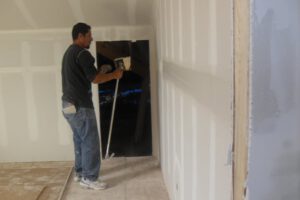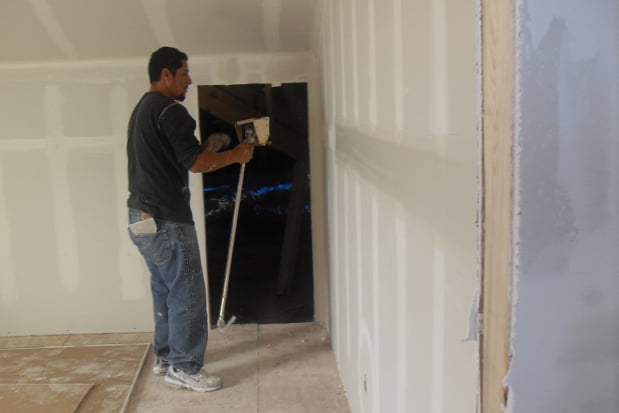Drywall is pretty durable, but dents and holes can occur from everyday activities like hammering in nails or aggressively moving furniture. Small dents and holes are more of a cosmetic concern, but larger ones can compromise the structural integrity of a wall.
Drywall Repair Las Vegas involves several steps and requires skills that professional handymen have developed over years of experience. Here are a few things you should know before trying to do it yourself:
Drywall, also called gypsum board or wallboard, is prone to water damage if not properly maintained or when moisture infiltrates the home. Whether caused by a plumbing leak, foundation or structural failure, or even flooding from storms and severe weather, the drywall must be repaired immediately to limit further damage and reduce the chance of mold growth.
Mold on drywall not only causes unsightly stains, but it can pose health risks to residents with preexisting conditions such as asthma or allergies. Additionally, mold spores can become airborne and spread throughout the home. If the spores are found to be toxic, it is essential that the drywall be removed and the area professionally cleaned to prevent any ill effects on residents.
Identifying drywall water damage is relatively simple, and the first sign of problems is often staining. Because drywall isn’t waterproof, any excess moisture will cause the paint to become discolored. Regardless of the color, sheen, or type of paint used on a home’s interior walls, discoloration will be a clear indicator that the drywall needs to be repaired and the affected areas properly dried before painting again.
Other common signs of drywall water damage include warping or swelling in the affected areas. The drywall may become swollen or warped as a result of the excess moisture, becoming soft and easily damaged.
Blistering on the surface of a wall is another clear indicator that the drywall needs to be replaced. Blistering is a sign of deeper water damage and should be repaired as soon as possible.
Foundation and structural failures
The drywall will show signs of foundation or structural failure when it begins to absorb water from the ground or from a leaky roof, as well as from any other sources. The drywall may become swollen, look distorted, sink, or even cave in. If any drywall is showing signs of water damage, it should be replaced as soon as possible to avoid further damage and reduce the risk of mold or structural failure.
To repair drywall with visible signs of water damage, it is important to drain any remaining water and then thoroughly wash down the affected areas with soap and hot water. It’s also crucial to allow the affected areas to fully dry before replacing them. This can be done by pointing an area fan at the wall, using a dehumidifier, and opening doors and windows to help circulate air.
Cracks
Cracks in the wall are almost always an unwelcome sight, but they’re not necessarily a sign of serious structural problems. In general, small cracks that are less than 3/16″ in length can be covered up with a good spackle job or joint compound. This is because these types of cracks are usually caused by the seasonal expansion and contraction of the wood frame.
If you notice a crack that is wider than this or is occurring in a corner, it’s time to call for professional help. Unless the cause is addressed, these cracks are likely to reappear and worsen over time.
Drywall Cracks
The most common type of drywall crack is a hairline or minor crack in the seam where two pieces meet. These cracks are typically caused by a combination of factors, including seasonal changes, building settlement, and construction issues.
In many cases, these types of drywall cracks can be repaired by reinforcing the joint with a piece of plywood or another suitable material. However, if the cause of the crack is structural, it will be necessary to replace the damaged section of the wall.
Most of the other cracks that occur in drywall are much more serious and require professional help. These include cracks that are wider than 1/8″ in width, cracks that appear along with sagging ceilings, and cracks that are discolored.
Holes in the wall are also very common, especially in newer homes. These holes can be caused by many different events, such as a run-in with the vacuum cleaner, aggressively hammering in a nail, or moving furniture around. The most common way to repair these holes is to use a patch kit. These kits come with a self-adhesive mesh patch that adheres to the hole and covers it.
Alternatively, you can repair large holes in drywall by cutting a patch out of a sheet of drywall that is larger than the hole and using a utility knife to cut out the damaged area of the wall. Then, apply the patch to the back of the drywall and secure it to the backing with drywall screws. Then, apply a thin layer of joint compound (also known as drywall mud) over the entire patch and smooth it till it is flush with the wall.
Loose joint tape
It is not uncommon for drywall tape to loosen over time, especially when the house was recently built. This is usually not a problem as long as the tape is embedded in a sufficient amount of drywall compound (also called “mud”), but it does require attention. If you see a strip of the corner tape pulling away from the wall, apply a new piece to the seam and spread an even coat of compound over it with your putty knife. This will help prevent future peeling.
If the loose tape is on a ceiling, use a ladder to reach the affected area. Remove the popcorn texture and re-mud the exposed area, following the same process as if it were on a wall. Be sure to wear a dust mask, as ceiling work can produce a lot of dust.
Drywall tape will come loose for several reasons, including water damage, insufficient mud being applied during the taping process, and humid conditions. Sometimes it can even be a sign of an active leak in the wall or ceiling. If you suspect this is the case, contact a professional for a thorough inspection.
The most common cause of loosened tape is moisture. If there is a serious leak, the moisture will soften the drywall compound and pull the tape loose from the surface of the wall. Other causes of loose tape include improper taping techniques, which can cause blisters or wrinkles on the tape that lose adhesion over time.
When this happens, you will need to re-tape the exposed seam with the proper application of drywall mud. This is best accomplished with self-adhesive mesh drywall tape, as it helps make the re-taping process easier. Be sure not to overlap the new tape with the existing tape on either end of the repair area, but you can leave up to 1 inch (2.54 cm) of a gap.
After the first coat of mud has dried, apply a second and possibly third coating to smooth and blend the taped area. Allow each coat to dry completely before sanding. Be sure to sand with the grain of the drywall to avoid leaving ridges.
Popped nails or screws
Even though popped nails and screws are more cosmetic than structural, it’s important to understand why they occur and how to correct them. It’s also important to know if popped nails are just a cosmetic issue or a warning sign of a more serious, possibly dangerous building defect.
Most often, drywall nail or screw pops are caused by shrinkage of the lumber used to frame the house. The wood swells and contracts with fluctuating temperatures, causing it to bend or poke into the drywall. This is most common in new-construction houses but can happen in older homes too.
A good contractor will inspect the studs behind the drywall for signs of rising trusses and wood shrinkage before starting to tape the walls. Drywall screw or nail pops will most likely be seen at this time and easily fixed before the drywall is taped.
Nail or screw pops are usually visible because they poke up through the top surface of the drywall or leave a small indentation in the drywall where the head was removed. A quick fix is to pound the screw or nail back into its stud. It is best to use a nail set or a drill instead of a hammer, which will dent the wallboard and make covering up the repair more difficult later.
Drywall nail or screw holes may be filled with lightweight spackling compound. A quarter-sized glob of compound spread with a putty knife should be sufficient to fill most nail or screw indentations. After the compound dries, it can be sanded and primed.
The corner where two sheets of drywall meet is protected by an L-shaped metal strip called a corner bead. It’s not indestructible, however, and can get dented from vacuum cleaner hoses running through the room, children flinging toys in corners, or heavy furniture being leaned up against it. This is easy to repair, but it requires the homeowner to be very careful and patient when attempting it.
A good fix for a corner bead that has been dented is to install a pair of drywall screws (not nails) where the drywall has been pulled away from the studs and re-tightened. The screws will cover the gap and prevent it from happening again.

